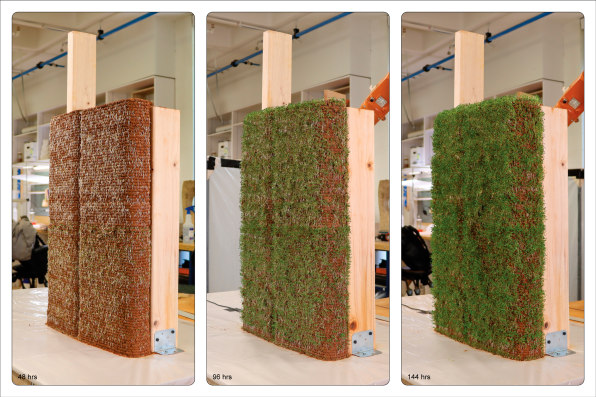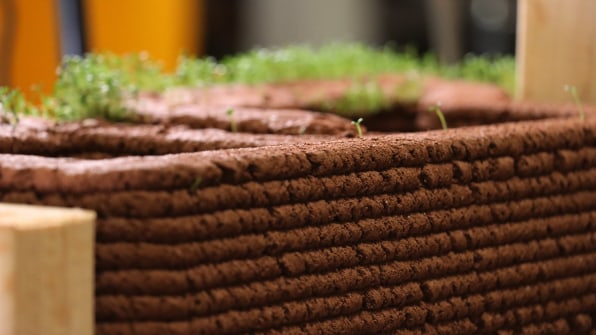- | 8:00 am
‘Bioconstruction’ will build homes out of flowering, 3D-printed dirt
Scientists have figured out how to build living structures out of extruded soil.

The walls of your home usually need to be spruced up with paint or some art, but one day they may be teeming with life instead.
Through a new approach to 3D printing, soil implanted with seeds can now be used as a concrete-like building material. Developed by a multidisciplinary team of researchers at the University of Virginia, this building technique could open up doors to a completely new kind of building, with finely tuned ecosystems of plants and bacteria forming the insulation, the structure, even the exteriors of homes.
“It becomes like a living tissue within your house,” says Ji Ma, an assistant professor of materials science and engineering at UVA who led this research, which was recently published in the journal Additive Manufacturing.

The project Ma and his collaborators developed is less grandiose than a living house. The team focused on small dome-shaped structures made of soil implanted with seeds. Balancing the quantity of soil, water, and seeds, and accounting for the compaction of pumping them all through the nozzle of a 3D printer, the team managed to create a small dome that was soon blossoming.
Ma concedes that building with soil isn’t entirely new. “One of the oldest construction materials is soil,” he says, pointing to adobe buildings in the American Southwest and mud huts in Africa, for example. “People were building structures from soil long before they were building with concrete.”
Using soil as the material for 3D printing expands its architectural potential. “You can create pretty complex structures with it,” Ma says. “The strengths are not very high, but they’re certainly high enough for standing up and keeping their shape.”

Others have been exploring similar territory. A team of researchers in Israel recently exhibited several small 3D-printed soil structures embedded with growing radish plants.
But there are broader implications to these advances than simply the novelty of turning a retaining wall into a Chia Pet.
Ehsan Baharlou, an assistant professor of architecture at UVA and a collaborator in this research, says this method could one day be used to print structures that incorporate a variety of soil and plant combinations, each serving a specific role in the way a building stands up or stays insulated. “We could change the material properties during fabrication in a way that you can have different kinds of functions,” he says. “You can have a green wall on one side and have structure on another side.”
Building with soil could also be a way to cut down the massive carbon footprint of buildings, particularly those made with carbon-intensive materials like concrete and steel. Embedding 3D-printed soil with plants could turn them into carbon sinks that absorb more CO2 than they produce.
Ma says the most immediate application for this technique may not be in buildings but in landscape architecture. How the soil is printed and how much water it’s supplied can effectively mimic different climate conditions in various parts of the world. “Potentially you have the ability to grow very different plant species that are normally adapted to different environments in the same place,” he says. “It has the potential for landscape architects to create menageries of different plant species, if you will,” he says.
Along with their collaborators, Ma and Baharlou are continuing to explore the potential. Baharlou says this approach dovetails with his other research into the possibility of using the fungus mycelium as a kind of living wall material. Combining a 3D-printed soil wall with mycelium-based insulation could be an early form of bioconstruction. More work is needed to understand how the plants, bacteria, and other organisms in such a system would interact or even compete with one another for resources like water and sunlight. “We need to define which kinds of species can work with each other,” Baharlou says.
For now, the researchers have shown that 3D printing soil and using it to grow plants is a viable concept. Controlling what happens when buildings start to operate like biological systems is the next challenge. “There’s almost no question that a structure can be built. The question is how do you incorporate the ecological aspect,” Ma says. “That’s where things get more difficult.”





































